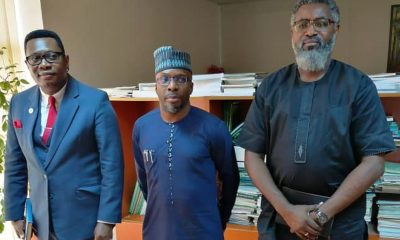Opinion
After Incentives, What Next?
With the recent range of incentives for teachers in the civil service by the federal government vis-à-vis special salary scale for basic and secondary school teachers; increase of mandatory service year from 35 years to 40 years; low-cost houses for teachers in the rural areas; special allowance for teachers in the rural areas; peculiar allowance for science teachers; automatic admission into public schools and free tuition for biological children of teachers and automatic employment for Education graduates, there is no doubt that teachers will be motivated and encouraged to put in their best in the discharge of their duties.
However, the commendable incentives may not produce the desired result in our pupils and students if nothing is done about the entire education system in the country. A recent report has it that Singapore has abolished school examination rankings. By this, a child’s report card will no longer be showing the position he took in class. The report card will, henceforth, not indicate class and level mean; minimum and maximum marks; pass/fail for end-of-year result; mean subject grades; overall total marks; L1R5 (English plus five relevant subjects), L1R4, EMB3 (English, Maths, best three subjects) and EMB1 for lower secondary levels.
According to the Ministry of Education, the essence of banning exam ranking is to teach the children that learning is not a competition but a self-discipline they need to master for life.
The report book should, however, still contain some form of yardstick and information to allow students to judge their relative performance, and evaluate their strengths and weaknesses.
Juxtapose this with what obtains in Nigeria and you will wonder what we are doing. Ours is a country where everybody wants to take the first position, where it seems education is a serious competition about who comes top in exams without necessarily knowing the subjects taught. It is not strange to hear stories of teachers, especially those in private schools, supplying answers to students during examinations so as to ensure they all pass with good grades. By this, their parents will be happy that their children are doing well and that the school is the best. What about schools that give first and other top positions to as many as five persons? Or the ones that make sure that the children of the rich are given good positions even when they do not merit it just to retain their parents’ patronage?
It’s true that countries have peculiarities in monitoring standards and performance in their school system and so Nigeria may not be obligated to copy what obtains in Singapore or any other country but what system are we really operating in our country and is it yielding the best result? Is it a system that teaches and encourages the use of foreign languages but prohibits the use of local languages? A system that promotes the learning of foreign cultures while the beautiful diverse cultures of the country are relegated to the background? Today, in some private schools, children pay up to N30, 000.00 per term to learn ballet dance. What efforts are made to teach the Nigerian dances?
Before and after Independence, the nation had the 6-5-2-3 system of education, which means six years in primary school, five years in secondary school, two years in higher school, and three years in the university. In the mid-1980s, it was abolished on the excuse that it was meant to serve the interest of the colonial masters and that it did not encourage science and technology, self-development and entrepreneurship.
Subsequently, the 6-3-3-4 system was introduced in the mid-80s by the then Minister of Education, Professor Babatunde Fafunwa. We were told that the system would bring functionality in the system by producing graduates that make use of their heads, hearts and hands. We all know how badly this system has been implemented. Years after the introduction, there were reports of abandoned crates and containers of workshop tools and implements and containers at the seaports. These were tools and equipment meant for children who may not be suited or equipped to go beyond JS3. Most of these tools and equipment were reportedly stolen by the suppliers and contractors with the eventual connivance of those in authority. So the junior secondary school students are being taught subjects like introductory technology, home economics and the likes without seeing or touching any tool for 3 years.
The resultant effect of the failure of this system is that many schools now adopt whatever system that appeals to them. In some primary schools, the last class is primary five, while some end in primary six. Some use the British/Nigerian curriculum, while others go for Nigeria/Canadian curriculum. The fact is that there is no uniformity of the education system. Schools spring up every day without proper supervision to ensure adequate quality of their content and effective delivery. The issue of the poor quality of teachers, lack of regular teachers’ training and corruption in the system and poor funding of the education sector is another ball game.
So the Nigerian education system needs urgent and comprehensive overhaul both from the policy direction and in the area of standard. The introduction of the 6-3-3-4 system over 20 years ago was the last major tweak in our education system and one thinks there is a need to take a critical look at what obtains in our schools and have a system change since the current one has obviously failed.
It is also my opinion that just as Singapore has done, we should de-emphasise examination but rather concentrate on imparting knowledge on the children in the most fun and interesting way. This will definitely yield better results than constantly subjecting them to series of tests and exams.
By: Calista Ezeaku
Opinion
The Girl Who Didn’t Dance
Opinion
Tradition or idolatry? The Debate Over Nhe-Ajoku

Opinion
Fubara’s Strategic Masterstroke

-

 News4 days ago
News4 days agoJAMB Conducts CBT Promotion Exams For 6,000 Directors
-
Sports4 days ago
Hoopers Ready For NPBL Title Defence – Captain
-
Politics4 days ago
Eno Sacks Aides Who Attended PDP Convention
-
News3 days ago
Rivers Community Marks Annual Wrestling Festival
-
Sports5 days ago
170 cycling challenge to make Lagos global hub for sports tourism
-

 Business4 days ago
Business4 days agoNigeria’s Inflation Rate Eases To 16.05% – NBS
-

 News4 days ago
News4 days agoNSCDC Arrests 20 Suspects For Alleged Threat To National Security
-
Health4 days ago
Police Hospital Reports More Malaria Incidence

